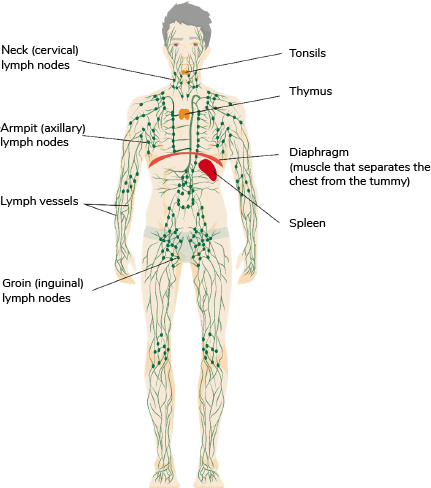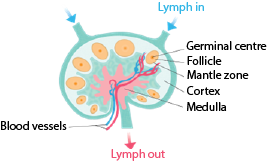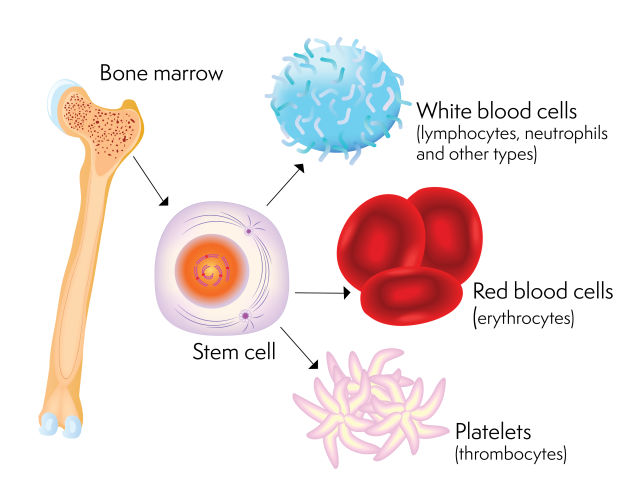The lymphatic system
Lymphoma is a type of blood cancer that develops in your lymphatic system. The lymphatic system is a network of tubes and tissues that runs throughout your body.
On this page
What is the lymphatic system?
The lymphatic system is a network of tubes, tissues and organs that runs throughout your body. It is part of your immune system, which helps protect you from infection.

The lymphatic system
The lymphatic system includes:
- lymphatic vessels that carry a fluid called lymph
- organs where immune cells develop:
- organs and tissues where immune cells collect ready to fight infection:
Any part of the lymphatic system can be affected by lymphoma.
The lymphatic system has three main functions:
- It drains fluid from your tissues and returns it to your bloodstream.
- It protects your body from disease by removing germs (bacteria, viruses and parasites) and toxins (poisons), and helps to destroy cells that are old, damaged or abnormal.
- It helps absorb fats and vitamins from your digestive system and transports them to your bloodstream.
Lymph
Lymph is the clear liquid that flows through your lymphatic system. It is formed from the fluid that surrounds all the cells in your body. This fluid drains from your tissues into tiny lymphatic vessels.
Lymph can contain:
- water
- sugars, proteins and fats
- vitamins, minerals and salts
- waste products from cells
- germs or toxins that have got into your body
- damaged or abnormal cells, including cancer cells.
Lymphatic vessels
Lymph travels through tubes called lymphatic vessels. Tiny lymphatic vessels in your tissues join to form gradually larger and larger lymphatic vessels, a bit like streams flowing into rivers. They eventually drain into large vessels called lymphatic ducts.
Lymph from the lymphatic ducts empties into large veins near your heart to enter your bloodstream. This removes excess fluid from around your body. Lymph is pushed along when your lymphatic vessels are squeezed by your muscles, and by gravity if the vessels are above your heart. One-way valves inside the vessels stop the lymph flowing backwards.
Lymph nodes
Lymphatic vessels pass through lots of ‘checkpoints’ called lymph nodes (sometimes known as lymph glands). Lymph nodes are small, bean-shaped structures. They are usually 1 to 2cm long.

Structure of a lymph node
You have hundreds of lymph nodes, found all over your body, except in your brain and spinal cord. They are often grouped together.
Some groups of lymph node are near the surface of your skin – for example, in your neck (cervical lymph nodes), armpits (axillary lymph nodes) or groin (inguinal lymph nodes). You can sometimes feel these if they swell up. This often happens if you have an infection and isn’t usually a sign of something serious. There are lots of other lymph nodes deep inside your body that can’t be felt from the outside – for example, in your chest (mediastinal lymph nodes) or tummy (abdominal lymph nodes).
Lymph nodes filter lymph. They trap germs and damaged or abnormal cells, and activate immune responses to help your body get rid of them.
Lymph nodes contain lots of white blood cells called lymphocytes. If you have an infection, the lymphocytes multiply inside your lymph nodes. They help fight the infection and make chemicals that activate other parts of your immune system. This is why your lymph nodes swell up when you have an infection. The swelling usually goes away in a couple of weeks, when the infection gets better.
Lymphocytes are the cells that grow out of control if you have lymphoma. If lymphoma cells build up inside your lymph nodes, the swelling does not usually go down.
Bone marrow
Bone marrow is the spongy tissue in the middle of some of the bigger bones in your body, such as your thigh bone (femur), breastbone (sternum), hip bone (pelvis) and back bones (vertebrae). Your bone marrow makes blood cells from special cells called stem cells. These are undeveloped cells that can divide and grow into all the different types of blood cell your body needs. These include red blood cells, platelets and white blood cells.

A bone marrow stem cell can develop into different types of blood cells
Lymphocytes (the cells that grow out of control if you have lymphoma) are a type of white blood cell. They are made in your bone marrow. Some of them fully mature there. These are called B lymphocytes. Others mature in your thymus. These are called T lymphocytes.
Thymus
The thymus is a small, butterfly-shaped gland in your chest. It sits behind your breastbone, just above your heart.
In the thymus, white blood cells called T lymphocytes develop into active immune cells. When fully developed, the T lymphocytes enter your bloodstream and lymphatic system.
Spleen
The spleen is an organ that filters your blood. It lies behind your ribcage on the left-hand side of your body, just behind your stomach. It is about the size of a clenched fist.
Your spleen contains lots of white blood cells, including lymphocytes. These cells help to protect you from infection by:
- removing germs from your bloodstream
- making antibodies
- activating other parts of your immune system.
Your spleen also removes old and misshapen red blood cells and platelets from your bloodstream. It stores a small supply of healthy red blood cells and platelets for your body to use in an emergency. If your bone marrow isn’t working as it should, your spleen can also be a back-up site for making new blood cells.
Mucosa-associated lymphoid tissue
‘Mucosa’ is the moist, protective layer of cells that lines many parts of your body, such as your mouth, gut and airways. ‘Lymphoid tissue’ means a collection of lymphocytes (white blood cells). Mucosa-associated lymphoid tissue (MALT) is a collection of lymphocytes in your mucosa.
You have MALT in lots of places in your body, especially areas where germs might be able to enter easily. MALT includes:
- the tonsils at the back of your throat
- the adenoids at the back of your nose
- bronchus-associated lymphoid tissue in your airways
- gut-associated lymphoid tissue in your bowel.
The immune cells in MALT protect you by trapping and destroying germs and toxins before they get further inside your body.
